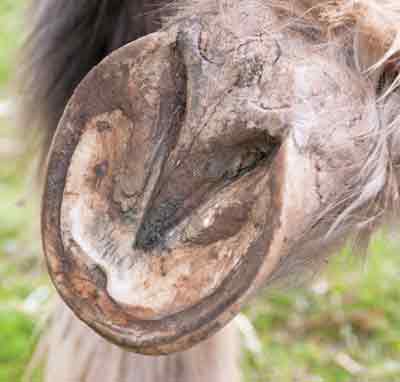
Abscess (hoof abscess, sole abscess)
Symptoms: Lameness, which can be severe; heat in the foot (hoof feels warm); swelling and redness in the bulbs of the heel; a dark area on the sole; pain when the affected area on the sole is pressed with a hoof pick or hoof testers.
What to do: Hoof abscesses aren’t emergencies. Many owners become adept at diagnosing and treating them, especially after they’ve done it a few times. If you’re not quite to that point, call your vet during regular hours. Severe abscesses that require paring of the sole should be treated by a vet.
To treat a hoof abscess, clean out the foot and then soak it in warm water with Epsom salts (about one cup per gallon of water) for 10 to 20 minutes. Moisten a 3-inch square piece of poultice pad (Animalintex) or disposable diaper, and smear povidone iodine (Betadine) or chlorhexidine ointment (Novalsan) on it. Place the pad on the bottom of the foot (over the abscess site if possible) and secure it with Vetrap, then with duct tape or elastic tape (Elastikon). Confine the horse in a clean, well-bedded stall or grassy paddock. Repeat the treatment every other day, or more frequently if the poultice bandage doesn’t stay on.
Outlook: Many hoof abscesses clear up with appropriate treatment, but some recur with distressing frequency. This usually means that the drainage was inadequate and/or the abscess site healed over prematurely, entrapping bacteria, which eventually forms another abscess. Horses that develop recurrent abscesses may need long-term antibiotic therapy to resolve the problem.
Back to Horse Health Glossary
This article originally appeared in the 2012 issue of Horses USA. Click here to purchase the most recent issue.





